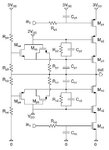nelly1
Junior Member level 3
problems about synchronous Buck converter with 2 switch
For my DCDC BUCK CONVERTER:
Vin=3.6V Vout=1.2V Iout=150mV f=1MHZ L=8uH C=0.25uF R=8Ω Vin1 signal=0-1.2V Vin2 signal=(2.4-3.6V)
I'm using the schematic below as the synchronous switch part for my buck converter.When Vin1 from 0-1.2, Vin2 from 2.4-3.6, nmos switch stack become "on" and pmos switch stack become "off" . Vout from 3.6-0 and vice versa.

It works quite well with a 100f capacitor as load and can provide me a pulse signal from 0-3.6V. The problem is, when i added these part into the buck converter system, the Vin1 signal (0-1.2V) after the RC lowpass looks like the picture 2,which belows 0 and then turn the Mn1,2,3 switch on(which i don't what it to happen.....)

My output now is something below.

I think the problem comes because the pmos switch is open and the nmos swtich also is open,so the current in inductor has no place to flow.
can I just add a diode in parallel with my nmos switch??????
For my DCDC BUCK CONVERTER:
Vin=3.6V Vout=1.2V Iout=150mV f=1MHZ L=8uH C=0.25uF R=8Ω Vin1 signal=0-1.2V Vin2 signal=(2.4-3.6V)
I'm using the schematic below as the synchronous switch part for my buck converter.When Vin1 from 0-1.2, Vin2 from 2.4-3.6, nmos switch stack become "on" and pmos switch stack become "off" . Vout from 3.6-0 and vice versa.

It works quite well with a 100f capacitor as load and can provide me a pulse signal from 0-3.6V. The problem is, when i added these part into the buck converter system, the Vin1 signal (0-1.2V) after the RC lowpass looks like the picture 2,which belows 0 and then turn the Mn1,2,3 switch on(which i don't what it to happen.....)

My output now is something below.

I think the problem comes because the pmos switch is open and the nmos swtich also is open,so the current in inductor has no place to flow.
can I just add a diode in parallel with my nmos switch??????
Last edited: